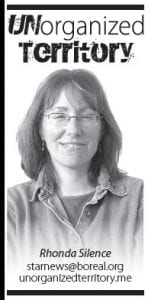I’ve ended up in a lot of meetings lately, as part of my job and as a citizen.
Right now, the all-important update of the Cook County Comprehensive Land Use Guide is under way. I went to the well-attended meeting at the Cook County Community Center on September 17. I was pleased to see the turnout and even more pleased to see that there was a lot of consensus on issues I care about. I’m looking forward to more discussion about what the county should look like in 15, 20 and 30 years.
There have also been meetings on the Highway 61 corridor as it passes through Grand Marais. Another good-sized crowd turned out at the Grand Marais Public Library recently to share concerns and to talk about possible improvements to the highway to make it safer and more pedestrian and bicycle friendly.
Because of these and the many other meetings I’ve attended recently, I almost passed on the presentation by the University of Minnesota- Morris at North House Folk School on Tuesday, September 23. I had started my day in a county board meeting and had a couple of interviews, so by 6:30 p.m. I was ready to just head home.
But the invitation from Jay Arrowsmith DeCoux about the UM-Morris Center for Small Towns statisticians was intriguing. Jay said he had had some interesting conversation at his B&B with Kelly Asche of the Center for Small Towns.
Jay was excited enough about it to arrange the presentation, so I decided to head to the talk at North House Folk School. I wanted to hear what the university had to say about Grand Marais.
I’m glad I did. The discussion about the “rural narrative” was enlightening. Asche and his co-presenter Jon Bennett talked about the supposed “brain drain” that is occurring in small towns in Minnesota. There is a huge concern about all the young people leaving our rural communities. Asche shared slides with dire newspaper headlines declaring that small towns were dying.
The duo shared statistics that show that is actually far from the truth. Small towns are changing, but they are not dying. In fact, Asche said, in Minnesota only two towns have dissolved in the last 50 years.
The demographics, not the populations, of towns are changing, said Asche. Young people are moving away— most likely to college and to experience the world. But that population is replaced by an older, more stable demographic.
In opposition to the theory that with young people leaving there is a “brain drain,” Asche said the people moving to rural areas bring education, experience and enthusiasm. He said there is actually a “brain gain.”
People who have had their fill of metro-area living are returning to rural life. People with children are moving to the country to raise their children. People are choosing quality of life over high salaries and the “rat race.”
Asche and Bennett had figures and charts to back up their statements. However, their assertion that people move to rural areas because of the quality of life was confirmed— and amplified—by the environment in which they were speaking.
The windows of the lovely “blue building” on the North House campus look out onto the periwinkle blue waters of Lake Superior. As they talked, the sky darkened and became streaked with soft pastels. Eventually it grew dark—until a brief flashing began—the soothing light of the Grand Marais lighthouse
It was distracting. I zoned out a little bit because of the lighthouse. I started thinking about hikes out to The Point and about ships on the lake. As I blinked and cleared my head to refocus on the presentation, I had to smile. That was exactly Asche’s point.
We are here because even though we must attend meetings, we can do so in such scenic spaces.
Perfect proof for his quality of life argument!
To read the papers and to listen to the news… one would think the country is in terrible trouble. You do not get that impression when you travel the back roads and the small towns do care about their country and wish it well.
Charles Kuralt



Loading Comments